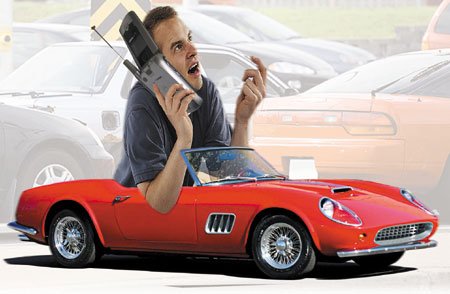Beginning July 1, the way Californians communicate will change,
many agree for the better, as two new laws go into effect
regulating cell phone use while driving.
Beginning July 1, the way Californians communicate will change, many agree for the better, as two new laws go into effect regulating cell phone use while driving.
Adults will only be able to use cell phones if they have a “hands-free” device, while teens younger than 18 won’t be allowed to talk or text or use any electronic device while driving.
Cell phones may still be used by teens and adults in emergency situations to call 911, law enforcement or medical personnel.
“Anything you can do to reduce the distractions within a vehicle while driving makes you a better driver and is good for overall traffic safety,” said CHP Officer Chris Armstrong. “There is currently a law being considered banning pets in the front seat of a vehicle. That would also be a help. We can’t stress it enough, that if you are a distracted driver, whether by cell phone conversations, eating or drinking while driving, whatever, you are not a safe driver and put yourself, your passengers and other drivers on the road in danger.”
Using a speaker or Bluetooth technology is permissible while adults only are driving. While there is no specific part of the law that bans dialing a phone or sending a text message, officers can cite motorists they believe were distracted and not operating a vehicle in a safe manner.
“A lot of cell phone usage resulting in accidents goes unreported, so to try to determined how many times an accident may have been caused by using a cell phone is difficult,” Armstrong said.
In May the Public Policy Institute of California released a study, “What to Expect from California’s New Hands-Free Law,” which examines the potential effect of a the new law. Based on the experience of the three states – New York, New Jersey and Connecticut – and Washington, D.C., where similar laws are already in effect, researchers concluded that the ban will reduce traffic deaths by about 300 a year, but only in adverse conditions, such as on wet or icy roads.
The analysis also found that because of the relatively modest penalties for using hand-held phones, and no prohibition against dialing and texting, even strict enforcement of the law might not discourage drivers from using their cell phones while driving.
“We know that cell phones are distracting, however, particularly for teens, and we are trying to get this information out to the public so people will be ready July 1,” Armstrong said. “Most people are aware that the laws are going into effect, but it may be confusing that it is July 1 instead of Jan. 1.”
Armstrong said parents of teen drivers need to be aware of the new law so they can be sure their young drivers are safe.
“That has always been one of my rules when my kids start driving,” said Morgan Hill resident Cindy Peterson, who has six children, four of whom are driving. “They knew they could not talk on their cell phones while driving. We’ve never had a problem, they understand why they can’t do that.”
In fact, she added, when she calls one of them on their cell phones and they are driving, they will tell her they can’t talk at that time because they are driving.
“Even though they may be good drivers, teenagers don’t have the experience that adult drivers do, and if they are trying to talk or text or something, they are not driving safely,” Peterson said.
Austin Gavin, 18, a senior at Sobrato High School, said the new laws are not going to make a big difference to him.
“I already try not to talk on the phone as much as possible because I know that distractions like that can double my odds for getting involved in an accident,” he said. “Because I like cars and racing, I know how very dangerous it can be to be a distracted driver.”
Gavin said he is not the lone voice of sanity among teenagers, that most of his friends and the people he knows tend to stay off the phone while driving.
“We know how dangerous it is,” he said.
CHP and other law enforcement officers will begin immediately enforcing the law July 1, Armstrong said. There is no “grace period” where officers will only give warnings, but, as with other violations, to issue a citation or a warning is at the discretion of the officer.
The two laws were the result of SB 1613 and SB 33, authored by Assemblyman Joe Simitian and signed into law by Gov. Arnold Schwarzenegger in September 2006.
According to information from the California Department of Motor Vehicles, the law pertaining to adults is what is termed a “primary violation,” which means an officer can stop a vehicle because he sees the driver talking on a phone without a hands-free device. However, for teens, using a cell phone or other electronic device while driving is a “secondary violation,” which means a teen driver can only receive a ticket if they are stopped for another reason.
A driver younger than 18 cannot use a hands-free feature even if the vehicle has the feature built in, as more and more do, except in an emergency situation.
Browning Grimmett, sales manager for South County Chrysler-Jeep-Dodge dealership in Gilroy, said he and his sales team remind customers about the impending laws, but find that most of them who are cell phone users are already aware.
“There are several options for people to prepare for the new law,” he said. “There’s a new system called Uconnect, a Bluetooth system built into the car that if your cell phone is able to use Bluetooth can hook up automatically, runs through your stereo system.”
The system can be installed on new vehicles or after-market with older vehicles. Options such as Uconnect are becoming more and more popular, he said.












